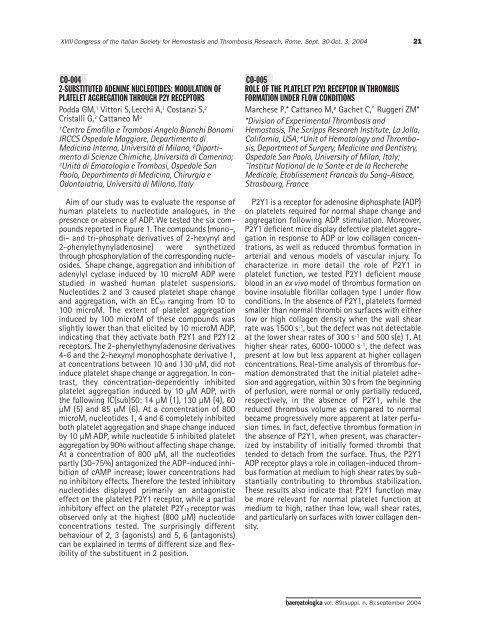Haematologica 2004;89: supplement no. 8 - Supplements ...
Haematologica 2004;89: supplement no. 8 - Supplements ...
Haematologica 2004;89: supplement no. 8 - Supplements ...
- No tags were found...
Create successful ePaper yourself
Turn your PDF publications into a flip-book with our unique Google optimized e-Paper software.
XVIII Congress of the Italian Society for Hemostasis and Thrombosis Research, Rome, Sept. 30-Oct. 3, <strong>2004</strong>21CO-0042-SUBSTITUTED ADENINE NUCLEOTIDES: MODULATION OFPLATELET AGGREGATION THROUGH P2Y RECEPTORSPodda GM, 1 Vittori S, Lecchi A, 1 Costanzi S, 2Cristalli G, 2 Cattaneo M 31Centro Emofilia e Trombosi Angelo Bianchi Bo<strong>no</strong>miIRCCS Ospedale Maggiore, Departimento diMedicina Interna, Università di Mila<strong>no</strong>, 2 Dipartimentodi Scienze Chimiche, Università di Cameri<strong>no</strong>;3Unità di Ematologia e Trombosi, Ospedale SanPaolo, Departimento di Medicina, Chirurgia eOdontoiatria, Università di Mila<strong>no</strong>, ItalyAim of our study was to evaluate the response ofhuman platelets to nucleotide analogues, in thepresence or absence of ADP. We tested the six compoundsreported in Figure 1. The compounds (mo<strong>no</strong>–,di– and tri-phosphate derivatives of 2-hexynyl and2-phenylethynylade<strong>no</strong>sine) were synthetizedthrough phosphorylation of the corresponding nucleosides.Shape change, aggregation and inhibition ofadenylyl cyclase induced by 10 microM ADP werestudied in washed human platelet suspensions.Nucleotides 2 and 3 caused platelet shape changeand aggregation, with an EC50 ranging from 10 to100 microM. The extent of platelet aggregationinduced by 100 microM of these compounds wasslightly lower than that elicited by 10 microM ADP,indicating that they activate both P2Y1 and P2Y12receptors. The 2-phenylethynylade<strong>no</strong>sine derivatives4-6 and the 2-hexynyl mo<strong>no</strong>phosphate derivative 1,at concentrations between 10 and 130 µM, did <strong>no</strong>tinduce platelet shape change or aggregation. In contrast,they concentration-dependently inhibitedplatelet aggregation induced by 10 µM ADP, withthe following IC(sub)50: 14 µM (1), 130 µM (4), 60µM (5) and 85 µM (6). At a concentration of 800microM, nucleotides 1, 4 and 6 completely inhibitedboth platelet aggregation and shape change inducedby 10 µM ADP, while nucleotide 5 inhibited plateletaggregation by 90% without affecting shape change.At a concentration of 800 µM, all the nucleotidespartly (30-75%) antagonized the ADP-induced inhibitio<strong>no</strong>f cAMP increase; lower concentrations had<strong>no</strong> inhibitory effects. Therefore the tested inhibitorynucleotides displayed primarily an antagonisticeffect on the platelet P2Y1 receptor, while a partialinhibitory effect on the platelet P2Y12 receptor wasobserved only at the highest (800 µM) nucleotideconcentrations tested. The surprisingly differentbehaviour of 2, 3 (agonists) and 5, 6 (antagonists)can be explained in terms of different size and flexibilityof the substituent in 2 position.CO-005ROLE OF THE PLATELET P2Y1 RECEPTOR IN THROMBUSFORMATION UNDER FLOW CONDITIONSMarchese P,* Cattaneo M, # Gachet C,^ Ruggeri ZM**Division of Experimental Thrombosis andHemostasis, The Scripps Research Institute, La Jolla,California, USA; # Unit of Hematology and Thrombosis,Department of Surgery, Medicine and Dentistry,Ospedale San Paolo, University of Milan, Italy;^Institut National de la Sante et de la RechercheMedicale, Etablissement Francais du Sang-Alsace,Strasbourg, FranceP2Y1 is a receptor for ade<strong>no</strong>sine diphosphate (ADP)on platelets required for <strong>no</strong>rmal shape change andaggregation following ADP stimulation. Moreover,P2Y1 deficient mice display defective platelet aggregationin response to ADP or low collagen concentrations,as well as reduced thrombus formation inarterial and ve<strong>no</strong>us models of vascular injury. Tocharacterize in more detail the role of P2Y1 inplatelet function, we tested P2Y1 deficient mouseblood in an ex vivo model of thrombus formation onbovine insoluble fibrillar collagen type I under flowconditions. In the absence of P2Y1, platelets formedsmaller than <strong>no</strong>rmal thrombi on surfaces with eitherlow or high collagen density when the wall shearrate was 1500 s -1 , but the defect was <strong>no</strong>t detectableat the lower shear rates of 300 s -1 and 500 s(e) 1. Athigher shear rates, 6000-10000 s -1 , the defect waspresent at low but less apparent at higher collagenconcentrations. Real-time analysis of thrombus formationdemonstrated that the initial platelet adhesionand aggregation, within 30 s from the beginningof perfusion, were <strong>no</strong>rmal or only partially reduced,respectively, in the absence of P2Y1, while thereduced thrombus volume as compared to <strong>no</strong>rmalbecame progressively more apparent at later perfusiontimes. In fact, defective thrombus formation inthe absence of P2Y1, when present, was characterizedby instability of initially formed thrombi thattended to detach from the surface. Thus, the P2Y1ADP receptor plays a role in collagen-induced thrombusformation at medium to high shear rates by substantiallycontributing to thrombus stabilization.These results also indicate that P2Y1 function maybe more relevant for <strong>no</strong>rmal platelet function atmedium to high, rather than low, wall shear rates,and particularly on surfaces with lower collagen density.haematologica vol. <strong>89</strong>(suppl. n. 8):september <strong>2004</strong>
















